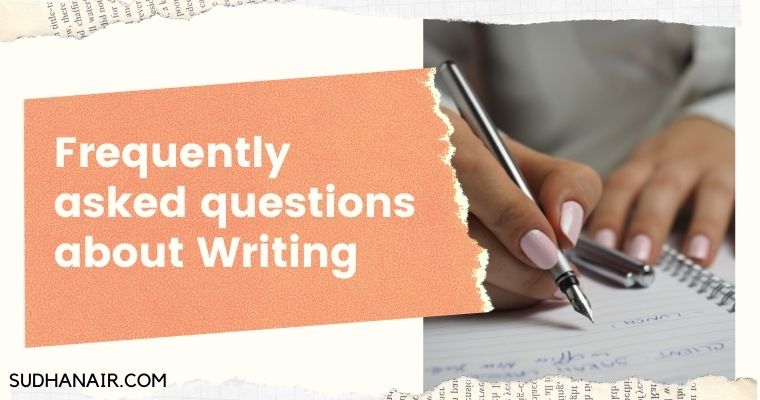The incredible thing about being a writer, apart from making up imaginary worlds, is talking about the writing craft.
When I began writing over a decade ago, I had all these questions about the writing process and craft. It’s likely that you have such questions too.
Below, I’ve tried to address some of the most frequently asked questions about writing. I hope these help you if you’ve been trying to find answers.
This post contains links to the Amazon affiliate program. As an Amazon Associate, I earn from qualifying purchases.
What’s the Difference Between Scenes and Chapters?
A scene is a single unit of time, character(s), and place. What I mean by that is every time the place, character(s), or time changes, it becomes a new scene. A scene is a beat-by-beat account of what is happening in the story. Scenes and sequels make up the story.
A scene is used to build a story and propel it forward. Scenes are used to depict big and small moments in a story. Every important action, moment, conflict in the character’s life, if made into a scene, plays in the mind of the reader as he/she reads it and keeps the reader engaged and interested in the story.
A chapter can contain one scene or many scenes. You can even split a scene to continue the scene in a new chapter. A chapter is a pause in the narrative and controls the pacing of a story.
To a reader, a chapter break is more of a psychological break in the story. Many readers like to read a chapter or two every night before bed. But if the chapter ends on a cliff-hanger, they tend not to be able to put the book down.
So, a good writer usually tries to end a chapter on a hook that makes the reader want to go on reading after the chapter. More on hooks, later.
There are many reasons to include a chapter break – sometimes to break narrative, to signal the end of a scene, to change the POV of a scene, etc.
For instance, in my book, Flames Of Desire, I have a chapter in which Dinesh takes Pooja to visit his aunt. This chapter starts with Pooja’s POV (I’ve used First Person Narrative), at the visit to Dinesh’s aunt, and the intimate moment they share in his mother’s old room, I then add a chapter break mid-scene to change to Dinesh’s POV. This chapter is in Dinesh’s perspective as the couple continues the moment in the previous chapter, and continues with Dinesh’s POV showing more scenes with Dinesh and Pooja at their aunt’s house, and back at the hotel to enjoy the barbecue dinner that evening.
In this example, I have used a chapter break to indicate a change in POV because I wanted to bring in both the characters’ perspectives to the visit to the aunt’s house and the intimate moment they share there. In novels written in First Person, it is standard practice to change the chapter when the POV changes. It brings more clarity when you break into a chapter as soon as the POV changes.
So, basically, to summarise, a scene is a single unit of the story, whereas a chapter is multiple units of narration in a story.
Should I Edit As I Go?
The simplest answer to this is NO.
Writing uses the creative side of the brain, whereas editing uses the logical side of the brain. Constantly shifting between these two sides of the brain causes the writing flow to freeze.
There are several times as writers that we want to perfect the sentence we’ve written before we move on. But what ends up happening is that we lose the stream of words that were coming through and end up with feelings of frustration and doubt.
So, the best practice is to write at one go without even stopping to fix spellings and grammar, and once the words are down on the page, then you can go ahead and edit those words.
I would even go as far as to say that it is better to finish writing the entire story or novel at one go, without editing, and then come back to edit what you need to change.
These are some of the basic reasons not to edit while you’re writing:
- Editing slows down the writing.
- Editing is a waste of time while you’re still writing because if you need to scrap a piece of writing, you would have wasted time editing what you didn’t need.
- Editing brings in doubt.
- Editing keeps you stuck in the loop of perfection.
Should I Use Real-Life Settings or Made-Up Settings?
Generally, fantasy authors use made-up settings while most contemporary authors use real-life settings. You can use real or made-up settings or a mix of both in your story. The most important thing to remember is that no matter whether your setting is real or made up, you need to bring authenticity to that setting in the story.
What I mean by this is that when you include a setting in a story, try to make it vivid by incorporating all your characters’ senses.
If it is a beautiful beach, let the character hear the crashing of the waves or watch the colours of the sky as the sun sets, let them feel the breeze in their hair or their toes slipping on the sand, taste the salt on their lips, and so on.
What makes any setting come alive in fiction is the character’s perception of it, and therefore the reader’s imagination. This is why readers sometimes even remember made-up settings as if they were real.
Is There Such a Thing as Too Much Backstory?
A backstory is the detailed history of the characters and all the events prior to the start of the actual story that you’re writing.
It is pertinent for the author to know the backstory for the purposes of understanding what makes the character be, do, behave, act, think, believe, etc, the way he/she does in the present story.
While the author tries to explore as much backstory as possible to be able to write a good story and understand certain nuances of the character better, the reader doesn’t need to know all the stuff that doesn’t pertain to the current story.
For example, Dinesh’s backstory in my book, Flames Of Desire is that he hates to come to India because of the memories of his mother’s passing away and blaming his father for his past. Now, it was important to know this backstory and pass it on to the readers so that they could understand why Dinesh hated being in India for the high-school reunion.
But it wasn’t important to know Dinesh’s backstory of what he did when he was away from the family for all those years, because that wasn’t pertinent to the story. As the author, I did develop a backstory for his habits, his attitudes, his beliefs, but they were for better character building and were woven into the story organically and not literally dumped in the present story.
So, what you need to remember is that too much backstory, especially which isn’t relevant to the present story can distract and frustrate readers and take them away from the story.
Some things to remember about backstory:
- Keep backstory in the story only if it’s related to what is happening in the story.
- Don’t do a backstory info dump that will bore readers.
- Instead, sprinkle the pertinent portions of backstory throughout the present story in places where the whys become important.
- Keep even the pertinent backstory to a minimum when woven into the story and spread them out to keep the reader interested and read further to find out more.
How do I write a good character?
A good character is a fleshed-out individual in your story. What that means is that your character not only has a name, a gender, and certain distinguishing facial and physiological characteristics but also qualities that will establish him/her in the reader’s memory.
A good character has attitudes, beliefs, flaws, virtues, backstory, and a uniqueness that makes up his/her personality.
A good character can be developed by keeping in mind that every character, just like a normal person, is unique. What he does, how he acts, what he says, etc, is wholly determined by everything that defines him/her as an individual.
For instance, using the previous example of my book, Flames Of Desire, Dr. Pooja is a caring person. How did I bring that across? Right in the first chapter, Pooja helps an old woman who’s missed her bus stop. Then, she helps a very drunk Dinesh. But, that’s not the only side to her. She also has strong opinions about marriage and family. She’s overworked and she hardly has any time for herself but she loves her job.
Dinesh is a character who is bitter about his past. He’s protective of the people he loves and he’s determined to make a success of his life. How did I bring all that across? In various instances in the story, I show how Dinesh is troubled by his past and how attached he was to his mother and the restaurant that he started in her memory. All these instances help flesh out Dinesh as a well-rounded character who is not only the protagonist/love interest in this story but also a good son, a great friend, etc. Thus, he becomes a very real person in the reader’s mind.
So, to create a good character:
- Give them thoughts, beliefs, actions like a real person.
- Give the reader a visual image of them as well.
- Give that character flaws and virtues which the reader can relate to as well as compare and contrast with other characters in the story.
- Make them more than superficial, cardboard characters.
I hope these answers have helped you understand the writing process and craft better. I hope to come back with more questions and answers about writing soon.
Check out Flames Of Desire:




